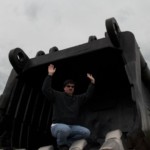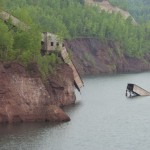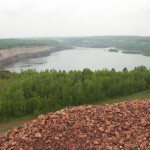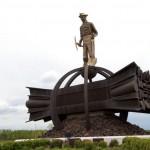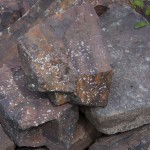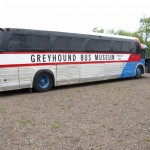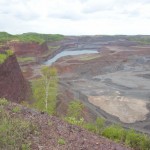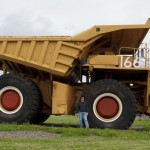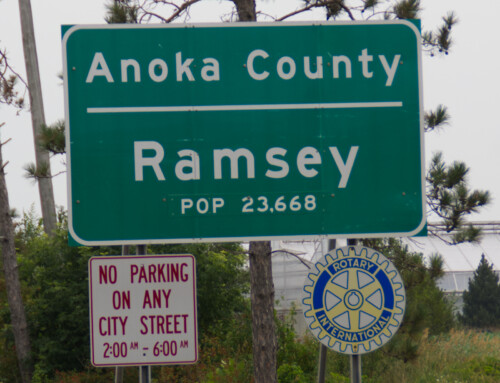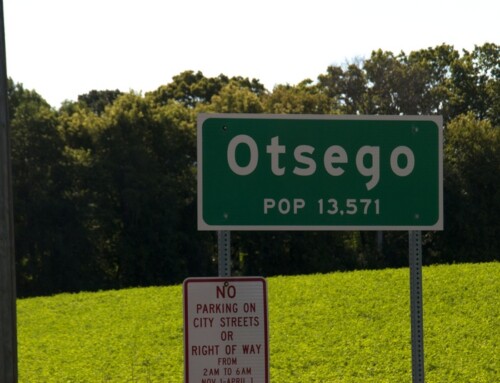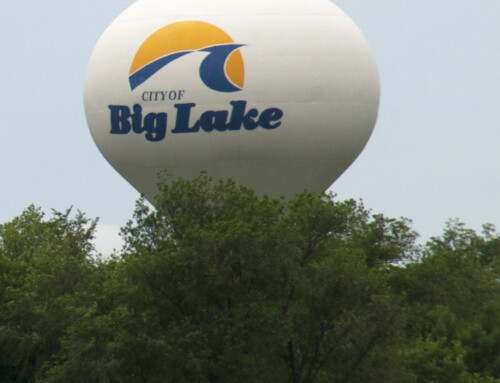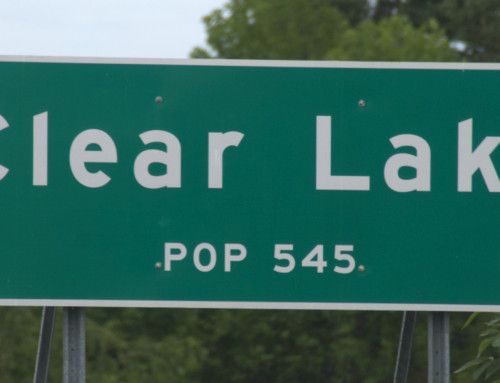Introduction
Feeding the insatiable demands of a modern superpower and consumer culture requires resources, and many of those resources are buried under the earth. There aren’t many places where meeting those demands has had a more in-your-face impact than Minnesota’s Iron Range. A landscape of pine forests and shallow lakes that was scraped flat by thousands of years of crawling ice sheets has, in just one century of human activity, been transformed into a region of deep lakes–pits dug by human beings to remove iron ore–and hills built high from the soil after the ore was removed. This is a fascinating region to explore and easily accessible from the Mississippi River town of Grand Rapids.
Visitor Information
Get your questions answered by the good folks at the Iron Range Tourism Bureau (218.749.8161).
History
Minnesota’s Iron Range is actually three distinct areas: the Vermillion Range, the Mesabi Range, and the Cuyuna Range. The Mississippi River skirts around the edge of two of those: the Mesabi and Cuyuna Ranges.
The Merritt brothers discovered iron ore on the Mesabi Range in 1890 (near the city of Mountain Iron), and within a short time mining created a boom economy. The first iron ore mine opened in 1892, and just 20 years later there were 150 operating mines. The industry did very well in the early years because the iron ore required little processing and was close to the surface, so it was cheap to extract. The mines were near major transportation routes (the harbor of Duluth was a short distance away by rail), and they had a vast resource of cheap labor as thousands of immigrants poured into the area (70% were from Finland, Sweden, Slovenia, and Croatia).
From 1900 to 1980, 60% of the US supply of iron ore came from the Mesabi Range. Much of the steel that fueled our war machine during World War II was produced from Minnesota iron ore. Iron ore production peaked during the war years, then gradually declined until the supply of high grade iron ore was essentially depleted by the 1960s.
In the 1970s a new process was employed that made it economical to process rock with a lower percentage of iron ore like taconite, which usually has a 15-35% iron ore content.. While high grade iron ore could just be dug out and shipped directly to steel mills, taconite has to go through several steps to make it mill-ready. After it was removed from the ground, the material has to be crushed, ground, screened, and baked to turn it into pellets that are about 67% iron. These pellets are then shipped to the steel mills.
Work in the mines has never been easy, so it shouldn’t be a surprise that the Iron Range has seen some major battles between management and labor. At the end of July 1907, thousands of miners went on strike at the Oliver Iron Mining Company (a subsidiary of US Steel), but the effort failed to win any concessions largely because there was a sufficient supply of new immigrants ready to work who were hired, even if many of those new immigrants were brought in by the company from east coast ports right after arriving in the US. By 1908, Oliver Mining dominated the range, controlling nearly three-quarters of the ore resources.
In the decade after the strike, over 700 men died in the mines, many of them new immigrants. Even though the work day had been reduced to eight hours from ten in 1912, management made it clear that they expected miners to produce the same amount. Most miners were paid a contract rate that was akin to a piece-rate; the more ore they dug out, the more they got paid, regardless of the number of hours worked. A typical contract worker in 1916 earned around $3 a day, which was a little higher than workers at open pit mines who were not on the contract system. The system was rife with abuse, though, as the rates were determined by mining captains who often demanded bribes for working prime spots and, at the end of the day, workers were charged for the supplies they used, things like fuses and blasting caps. Oliver Mining vigorously opposed formation of unions and hired spies to monitor its workers; anyone suspected of trying to organize was fired.
As discontent with the pay system grew in 1916, scattered strikes broke out, many led by men from the group of new immigrants hired in 1906. Mainstream labor organization weren’t willing to help, so the workers turned to the more radical Industrial Workers of the World, who were eager to assist. The IWW helped organize a widespread strike of thousands of miners and drew up a list of demands that included better pay, abolishing the contract system, and ending 4-hour shifts on Saturdays.
Striking miners survived for a while on funds from the IWW, but many also had to go out west and work in seasonal harvesting to support their families. Because of World War I, the company couldn’t rely on a supply of new immigrants to break the strike, so they instead worked with local authorities to slow down the union leadership by arresting and charging them with trumped-up violations. The company also hired a large network of security forces, that, with the blessing of the Governor, were deputized in St. Louis County. Those forces were later implicated in the escalation of violence (four people were killed during the strike) that at the time was blamed on the IWW and striking miners.
After 3½ months the strike ended, largely because of financial pressures on the striking miners as IWW funds dried up and seasonal work out west ended. Many returned to work in the mines. Within a month of the end of the strike, Oliver raised wages 15-20% and adopted many of the reforms sought by the union; although contract work wasn’t ended, more oversight and protections for workers were added. Oliver continued to fight union organizing and managed to keep them out of the mines until 1943.
While folks on the Iron Range have a long history of pro-union politics, many are also socially conservative. When the mines began hiring women in the 1970s, the new employees were subjected to daily harassment and humiliation from male coworkers; management didn’t intervene, implying that the female workers brought it on themselves. A successful class action lawsuit was settled against Eveleth Mines in the late 1990s (Jensen v. Eveleth Taconite Company), setting a landmark for future sexual harassment claims.
Even with an increase in tourism-related jobs, the mines are still a reliable employer, although the number of jobs is much less than it once was. While those new jobs in the service sector often pay minimum wage or just above, a job in the mines will typically pay 2-3 times as much.
Exploring the Area
There are a number of places to visit in the Mesabi Range that will give you a good overview of the mining industry. When visiting the area, keep in mind that folks in the Iron Range don’t necessarily warm to strangers quickly, but hang in there. When I went to a Slovenian bar in Chisholm for happy hour, two guys talked around me for half an hour before one of them turned to me and said “I didn’t catch your name.” I was involved in the conversation after that. Don’t give up just because someone doesn’t want to hear all about your family vacation in the first five minutes after they met you.
Chisholm
(2010 Population = 4,976)
Head to the Minnesota Discovery Center (1005 Discovery Dr.; 218.254.7959) for an overview of the history of mining in the Iron Range. Think of it as a mining theme park, complete with mini-golf, an amphitheater, a 19th-century village, museum, and archives. The museum has a number of good displays, including the Hall of Geology with lots of cool rocks, and an informative video that shows the whole mining process.
Across the highway from the Minnesota Discovery Center, the Iron Ore Miner Statue (US Highway 169) is dedicated to all those who have labored in the mines. At 81 feet tall, it is the third tallest freestanding sculpture in the US (behind the Arch and the Statue of Liberty). Sculptor Jack Anderson created the piece from Corten steel and covered it with brass, copper, and bronze. Each miner’s boot weighs 220 pounds.
The Minnesota Mining Museum (701 W. Lake St.; 218.254.5543) has an impressive collection of large mining equipment like the 1910-era Atlantic Steam Shovel. Check out the railroad diorama in the depot crafted by renowned artist Francis L. Jaques. The museum is in the center of town.
Hibbing
(2010 Population = 16,361)
Hibbing was founded in 1893 by Frank Hibbing, but the original site (known as North Hibbing) had to be abandoned beginning in the 1910s to accommodate an expanding mine. Nearly two hundred buildings were moved south over the course of several decades to the neighboring village of Alice (now part of Hibbing). North Hibbing is now a park where you can play disc golf around the streetscape and foundations of the original village.
Take a detour to north Hibbing for a look at one of the world’s largest open pit mines. The views at the Hull Rust Mine View (611 McKinley St.; 218.262.4166; free; open May-Sept.) are jaw dropping, plus you get a closeup view of the massive trucks and shovels used to extract iron ore.
The Mesaba Transportation Company began service by transporting miners and their families between home and work, primarily between North and South Hibbing. You know the business today as the Greyhound Bus Company. You can learn all about their history at the Greyhound Bus Museum (1201 Greyhound Blvd.; 218.263.5814). One highlight is the collection of restored buses from different eras. If you have any memories of long-distance bus travel—like I do—this place will stir up nostalgia, like the time I took a 30-hour ride to bowling camp.
Bob Dylan graduated from Hibbing High School in 1959 when he was still known as Bobby Zimmerman. You can pick up an audio or print walking tour of Dylan sites from the Hibbing Public Library (2020 5th Ave. E; 218.362.5959; download a tour) Highlights include the house where he grew up (2425 7th Ave. E) and the Dylan collection at the library.
While in Hibbing, it’s worth a little extra time to tour the magnificent Hibbing High School (800 E. 21st St.). Mining companies spent $4 million in 1923 to build the grand structure as payback to the families who were displaced from North Hibbing for a new mine. The 1,805-seat auditorium is unbelievably ornate for a high school. Go in the main entrance and to the office to pick up a brochure and to let them know you’re not a creep who likes to wander around high schools. During the school year, you can visit the building between 9 a.m. and 2 p.m.; in summer, look for guided tours.
Virginia
(2010 Population = 8,712)
Artists Gareth Andrews and Byron Kesanen crafted The Sawyer (Rotary Park; 4th St. N at 6th Ave. W) from Corten steel, a material that takes on a rust color as it ages. The sculpture depicts a sawyer sharpening an impressive blade.
Minnesota’s state bird is the loon, and the biggest one you’ll ever see sits in the middle of Silver Lake (9th Ave. W across from Mesabi Range College). Ginny the Loon is some 21-feet long and calls the lake home when it’s not frozen.
Eveleth
(2010 Population = 3,718)
Fans of frozen sports will want to detour to Eveleth to tour the US Hockey Hall of Fame Museum (801 Hat Trick Ave.; 218.744.5167), which is chock full of memorabilia on the sport in the US.
As long as you’re here, you should also stop for a photo op at The Big Stick & Puck (Grant Ave. at Monroe St.), the world’s largest hockey stick, quite possibly used by Paul Bunyan.
Tours
Volunteers at Hill Annex Mine State Park at Calumet (880 Gary St.) takes folks on tours of the former open pit iron ore mine that operated from 1912-1978. The 90-minute tours focus either on fossil hunting or the historic mine. Call the park to confirm that tours are running and to make a reservation (218.247.7215).
Bob Dylan grew up in Hibbing, graduating from Hibbing High School in 1959 when he was still known as Bobby Zimmerman. You can pick up a brochure with a walking tour of Dylan sites at the library or download here. The highlights include the house where he grew up (2425 7th Ave. E.) and the Dylan collection at the Hibbing Public Library.
**The Mesabi Iron Range is covered in Road Tripping Along the Great River Road, Vol. 1. Click the link above for more. Disclosure: This website may be compensated for linking to other sites or for sales of products we link to.
Where to Eat and Drink
In Hibbing, the Sunrise Deli (2135 1st Ave.; 218.263.5713) has a nice selection of take-out food, including regional specialties like sarma.
For a sit-down meal paired with a locally brewed beer, head BoomTown Brewery and Woodfire Grill (Hibbing: 531 E. Howard St.; 218.440.1710). The menu is loaded with comfort food favorites, and the taps dispense an impressive range of beer.
Where to Sleep
Hibbing and Virginia have a few chain hotels to choose from; otherwise, Grand Rapids is a convenient base for exploring the area.
Where to Go Next
Next stop downriver: Jacobson
Next stop upriver: Grand Rapids
Community-supported writing
If you like the content at the Mississippi Valley Traveler, please consider showing your support by making a one-time contribution or by subscribing through Patreon. Book sales don’t fully cover my costs, and I don’t have deep corporate pockets bankrolling my work. I’m a freelance writer bringing you stories about life along the Mississippi River. I need your help to keep this going. Every dollar you contribute makes it possible for me to continue sharing stories about America’s Greatest River!
Mesabi Iron Range Photographs
- Hill Annex Mine; Calumet, Minnesota
- Hill Annex Mine; Calumet, Minnesota
- Hill Annex Mine; Calumet, Minnesota
- Ironman Memorial; Chisholm, Minnesota (can you spot the person in the photo?)
- Iron ore
- Hull Rust Mahoning Mine; Hibbing, Minnesota
- Hull Rust Mahoning Mine; Hibbing, Minnesota
- Hull Rust Mahoning Mine; Hibbing, Minnesota
A Song for the Mesabi Iron Range
The Girl from the North Country, written by Bob Dylan and performed here by Dylan with Johnny Cash (1969)
©Dean Klinkenberg, 2024, 2021, 2018,2013,2011
